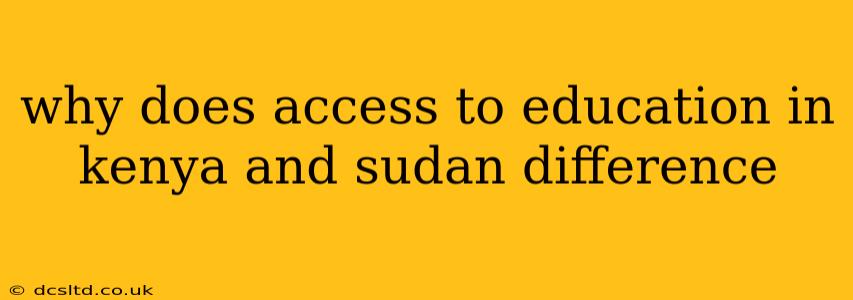Why Does Access to Education Differ in Kenya and Sudan?
Access to education in Kenya and Sudan, while both facing significant challenges, differs considerably due to a complex interplay of factors. Understanding these disparities requires examining political stability, economic conditions, geographical factors, cultural norms, and government policies.
What are the main differences in access to education between Kenya and Sudan?
The most significant difference lies in overall access rates and the quality of education offered. While both countries have made strides in increasing enrollment, Kenya generally boasts higher primary and secondary school completion rates compared to Sudan. This disparity is reflected in literacy rates and educational attainment levels. Kenya has invested more heavily in infrastructure, teacher training, and curriculum development, leading to relatively better educational outcomes. Sudan, on the other hand, has faced prolonged periods of conflict and instability, hindering its progress in education.
What are the key factors affecting access to education in Kenya?
Kenya faces challenges such as:
- Inequality: Disparities in access exist based on socioeconomic status, geographic location (rural vs. urban), and gender. Children from impoverished backgrounds, those living in remote areas, and girls often face significant barriers to accessing and completing education.
- Funding: While Kenya has made commitments to education financing, funding remains a challenge, particularly for maintaining infrastructure, providing quality teaching materials, and ensuring adequate teacher salaries.
- Infrastructure: While improving, infrastructure in some regions remains inadequate, with schools lacking sufficient classrooms, sanitation facilities, and learning resources.
- Teacher quality and training: Ensuring well-trained and motivated teachers remains crucial. Teacher shortages, particularly in rural areas, and inadequate professional development opportunities pose challenges.
What are the key factors affecting access to education in Sudan?
Sudan's educational landscape is profoundly shaped by:
- Political instability and conflict: Decades of civil war and political upheaval have severely disrupted the education system. Displacement, destruction of schools, and the diversion of resources to military spending have greatly hindered progress.
- Poverty and economic hardship: Widespread poverty limits families' ability to afford school fees, uniforms, books, and other educational expenses, forcing many children to drop out.
- Geographic challenges: Sudan's vast and diverse geography presents logistical difficulties in providing access to education in remote and underserved areas.
- Cultural norms: Cultural barriers, such as early marriage for girls and traditional gender roles, contribute to lower enrollment and completion rates for girls.
- Lack of resources: Limited funding, inadequate infrastructure, and a shortage of qualified teachers compound the challenges.
How does government policy impact education in both countries?
Both Kenya and Sudan have implemented various education policies aimed at improving access and quality. Kenya's emphasis on free primary education has significantly boosted enrollment, although challenges in quality and equity persist. Sudan's education policies have been hampered by political instability and resource constraints. Effective implementation and consistent funding are essential for meaningful improvements.
What are the future prospects for education in Kenya and Sudan?
Both countries face significant hurdles in providing equitable and quality education for all. Sustained political stability, increased investment in education, improved infrastructure, and focused efforts to address inequalities are crucial for progress. Addressing the root causes of educational disparities, such as poverty and conflict, is paramount for achieving universal access to quality education in both Kenya and Sudan. International collaborations and aid can play a vital role in supporting these efforts.
